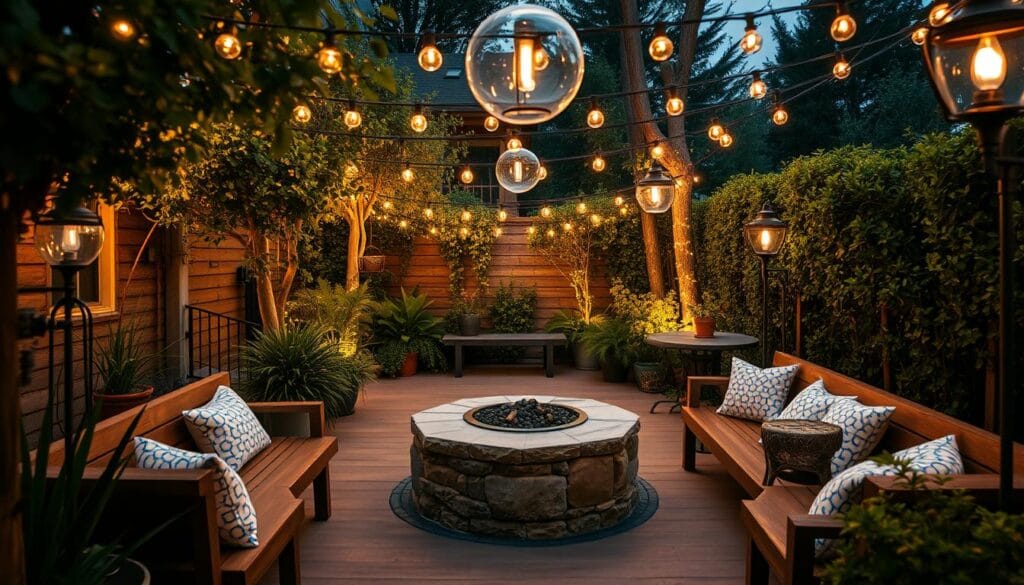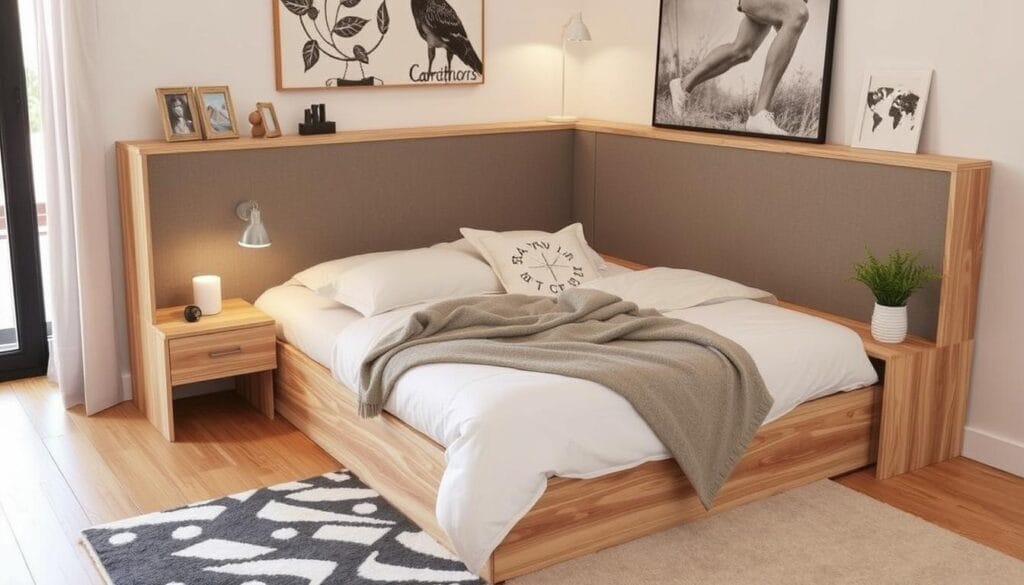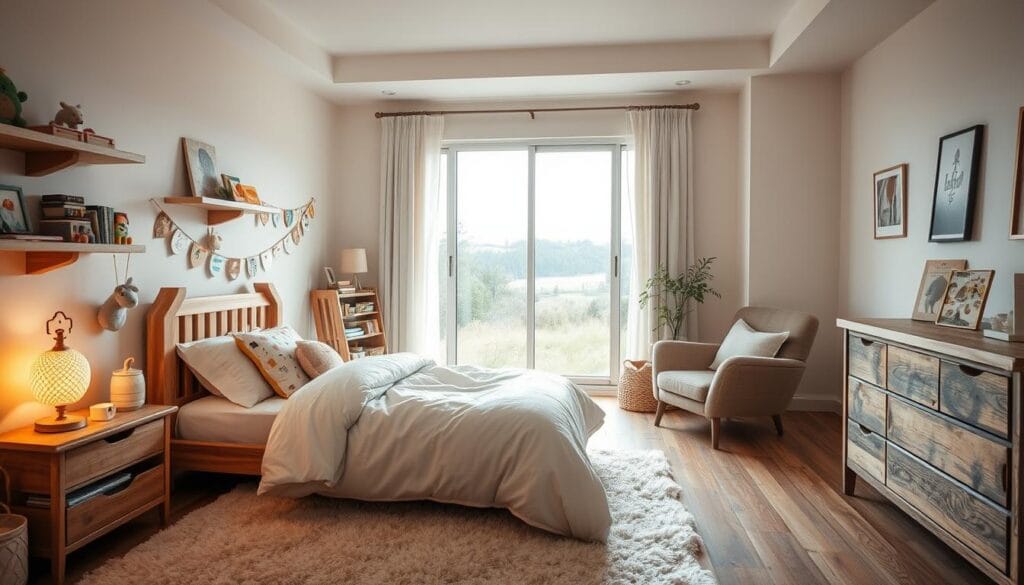Transforming your living space into a stylish sanctuary is easier than you think. With the right aesthetic home decor and home interior design ideas, you can create a personalized space that reflects your personality and style.
Your home’s interior design plays a significant role in making it feel comfortable and visually appealing. By understanding the fundamental principles of interior design and exploring different design styles, you can strike the perfect balance between trendy elements and timeless style choices.
Discover how small changes can make a big impact on your space‘s overall aesthetic, and learn how to identify your personal design preferences to create a truly unique and inviting atmosphere.
Table of Contents
Key Takeaways
- Learn how to transform your living space with aesthetic home interior design ideas.
- Understand the fundamental principles of interior design that make a space beautiful and functional.
- Explore different design styles to reflect your personality and create a comfortable atmosphere.
- Balance trendy design elements with timeless aesthetic choices.
- Get inspired by various interior decor approaches that fit your space and budget.
The Essence of Aesthetic Home Interior Design
The essence of aesthetic home interior design lies in its ability to merge form and function, creating a harmonious and inviting atmosphere. You want your home to be a reflection of your personal style while also being functional and comfortable.
What Makes a Space Truly Aesthetic
A truly aesthetic space is one that balances visual appeal with practicality. This balance is achieved through thoughtful placement of design elements, such as furniture, lighting, and color, which create visual harmony while serving practical purposes. To create such a space, you need to understand how different elements work together.
Balancing Beauty and Functionality
Balancing beauty and functionality is crucial in interior design. You need to consider how color theory, spatial awareness, and material selection contribute to creating a cohesive aesthetic. By doing so, you can create a home that reflects your lifestyle while maintaining design integrity.
To achieve this balance, consider the role of lighting, texture, and scale in enhancing the overall feel of your interior spaces. By thoughtfully combining these elements, you can create a space that is both beautiful and functional.
Popular Aesthetic Home Interior Design Ideas
The latest aesthetic home interior design ideas for 2025 are all about merging functionality with sustainability and wellness, creating spaces that are both beautiful and beneficial for your well-being. Whether you’re drawn to the minimalist coziness of Japandi, the rich textures of natural stone, or the bold statement of maximalism, there’s a trend to suit every taste.
Current Trends Shaping Home Aesthetics
Current trends in home aesthetics are heavily influenced by the need for sustainability and wellness. Design styles that incorporate natural materials, energy-efficient solutions, and spaces that promote mental and physical health are gaining momentum. For instance, Japandi style, with its emphasis on minimalism and natural materials, is becoming increasingly popular for its ability to create calm, clutter-free spaces.
Timeless Elements That Never Go Out of Style
While trends come and go, certain design elements remain timeless. These include classic decor pieces, high-quality materials, and thoughtful lighting design.
Incorporating such elements into your home not only adds aesthetic value but also ensures that your space remains stylish and relevant regardless of changing trends. For example, natural stone features and well-chosen artwork can elevate your interior design, providing a lasting appeal.
Scandinavian Design: Clean and Cozy
Scandinavian interior design is distinguished by its use of neutral color palettes, natural materials, and clutter-free spaces. This style combines the principles of minimalism with coziness and functionality, creating a unique aesthetic that is both clean and inviting.
Key Elements: Neutral Palettes and Natural Materials
The foundation of Scandinavian design lies in its use of neutral color palettes and natural materials. Neutral tones such as whites, grays, and beiges dominate the color scheme, while natural wood tones and organic textures add warmth to the space. This combination creates a balanced and harmonious atmosphere.
Creating Hygge in Your Living Space
Hygge, a Danish concept, is about creating coziness and comfort in your home. To incorporate hygge into your living space, focus on adding elements like high-pile rugs, soft lighting, and cozy textiles. These elements work together to create a warm and inviting atmosphere, perfect for relaxing and unwinding.
Mid-Century Modern: Retro Sophistication
Characterized by clean lines, organic forms, and minimal ornamentation, Mid-Century Modern design remains a popular choice for homeowners seeking a retro-sophisticated look. This design style, which emerged in the post-war era, is defined by its emphasis on functionality and aesthetic appeal.
Iconic Features and Silhouettes
Mid-Century Modern design is distinguished by its use of warm wood paneling, brown bathroom tiles, and chrome plumbing. The influence of Japanese design is also evident in American Mid-Century Modernism. Iconic furniture pieces include sofas with clean lines, egg-shaped chairs, and coffee tables made from teak or walnut.
Incorporating MCM Pieces Without Looking Dated
To incorporate Mid-Century Modern pieces into your home without looking dated, balance vintage furniture with contemporary elements. For instance, pair a vintage MCM sofa with a modern coffee table or add MCM-inspired decor to a room with contemporary furnishings. This blend creates a fresh, curated look that honors the MCM era while feeling modern.
When shopping for authentic Mid-Century Modern pieces, look for materials like teak, walnut, and molded plastic, which define the material palette of this design style. By thoughtfully integrating these elements, you can achieve a retro-sophisticated aesthetic that feels both timeless and current.
Bohemian Style: Free-Spirited Expression
Characterized by its mix of global influences and artfully mismatched elements, Bohemian style is perfect for those who dare to be different. This design style celebrates individuality and creative expression, making it ideal for those who want a unique home.
Mastering Pattern and Color Mixing
One of the key elements of Bohemian interior design is the art of mixing patterns and colors in a way that feels harmonious rather than chaotic. To achieve this, start by selecting a few core colors and then layering different patterns and textures around them.
Layering Textiles and Global Influences
Textiles play a crucial role in creating authentic Bohemian spaces. From tapestries and macramé to plush pillows and throws, layering different textiles adds depth and warmth to your decor. Incorporating global influences, such as Moroccan tiles or Indian prints, further enriches the style of your space.
By embracing the eclectic nature of Bohemian design, you can create a space that truly reflects your personality. Don’t be afraid to experiment with different design elements until you find a look that feels like you.
Industrial Design: Urban Elegance
Embracing the raw beauty of industrial elements can transform your living space. Industrial design is characterized by its use of raw materials and exposed elements, creating a distinctive look that is both rustic and mature.
Raw Materials and Exposed Elements
The foundation of industrial aesthetics lies in materials like steel, concrete, reclaimed wood, and exposed brick. These elements bring a sense of architectural honesty and raw beauty to your space. Exposed structural elements such as beams, pipes, and brick walls become design features rather than elements to hide.
Key materials used in industrial design include: steel, concrete, reclaimed wood, and exposed brick.
Softening Industrial Spaces for Comfort
While industrial spaces are known for their raw elements, it’s essential to soften them to make them feel welcoming and comfortable. You can achieve this by creating contrast between hard industrial materials and softer textiles. Lighting choices, such as factory-inspired pendants or vintage task lamps, can also enhance the industrial mood.
To make your industrial space feel more livable, consider incorporating warmer elements like rugs, throw blankets, and comfortable seating.
Japandi: East Meets North
By merging Japanese minimalism with Scandinavian comfort, Japandi creates a serene and inviting atmosphere in any space. This design style is characterized by its use of natural materials, neutral color palettes, and functional beauty.
Blending Japanese Minimalism with Scandinavian Comfort
Japandi interior design beautifully blends the simplicity of Japanese minimalism with the coziness of Scandinavian style. You can achieve this aesthetic by incorporating low furniture, natural textures, and a neutral color palette. The result is a calm and clutter-free environment that feels both serene and welcoming.
The concept of “wabi-sabi,” or finding beauty in imperfection, plays a significant role in Japandi design. You’ll often see imperfect ceramics and natural fiber textiles that add character to the space.
Natural Materials and Functional Beauty
Natural materials such as light woods, bamboo, and paper are essential elements in creating an authentic Japandi environment. These materials not only add warmth but also contribute to the functional beauty of the space. Every object in a Japandi-designed room serves a purpose while being aesthetically pleasing.
To enhance the Japandi aesthetic, focus on thoughtful space planning and maintaining clutter-free environments. This approach contributes to the peaceful atmosphere that defines this design style.
Maximalist Design: Bold Expression
Maximalist design is an art form that celebrates opulence and self-expression. It’s a design style that thrives on abundance, personality, and visual interest, making it the perfect choice for those who want their living space to be a reflection of their unique character.
Embracing Color, Pattern, and Texture
To create a maximalist interior, you need to be bold with your choices. This involves embracing a wide range of colors, mixing various patterns, and incorporating different textures to add depth and character to your space. The key is to be intentional with your design choices, ensuring that your space feels curated rather than chaotic.
Start by selecting a palette that’s rich and vibrant. Don’t be afraid to combine different hues and shades to create a look that’s truly yours. When it comes to patterns, mixing and matching is encouraged. From florals to geometrics, the more varied your patterns, the more visually interesting your space will be.
Creating Harmony in Visual Abundance
Achieving harmony in a maximalist design is all about balance. With so many elements competing for attention, it’s crucial to create focal points and visual pathways that guide the eye through the space. This can be done by using statement pieces, such as bold artwork or oversized furniture, to anchor the room.
Another technique is to layer different design elements. For instance, combining decor items like vintage rugs, layered lighting, and eclectic accessories can add layers of interest to your space. The goal is to create a cohesive story despite the abundance of elements, making your space feel like a curated collection rather than a cluttered room.
Transitional Style: Timeless Fusion
Transitional interior design seamlessly merges traditional elegance with contemporary simplicity, creating a timeless aesthetic. This versatile interior design style is perfect for those who appreciate both classic and modern elements.
Bridging Traditional and Contemporary Elements
Transitional design combines simple geometric shapes with mild sculpting and etching inspired by traditional patterns. This blend results in a unique aesthetic that is both sophisticated and inviting. By incorporating neutral color palettes, you can create a perfect backdrop for your transitional space, allowing for personalization through furniture and decor choices.
Creating Balanced and Versatile Spaces
To achieve a balanced transitional space, focus on furniture with clean lines and comfortable proportions. Mixing materials and textures adds depth and interest to your interior. The key is to strike a balance between different design elements, ensuring the space feels neither too formal nor too casual.
By understanding the principles of transitional style, you can create a harmonious and inviting atmosphere in your home. This design approach remains popular due to its adaptability and broad appeal, making it an excellent choice for many homeowners.
Transforming Spaces with Color Psychology
The power of color psychology lies in its ability to completely transform the mood and feel of your interior spaces. By understanding how different colors affect human emotions and behaviors, you can create a space that is both aesthetically pleasing and emotionally resonant.
2025 Color Trends for Interior Design
Rich jewel tones will continue to dominate interior design in 2025. Emerald green, sapphire blue, and amethyst purple are versatile colors that fit many decor styles, infusing rooms with a sense of luxury and opulence. These vibrant hues work exceptionally well as accents or focal points. To balance them, pair with neutral elements and pastels like butter yellow for a calmer look.
Strategic Color Placement for Maximum Impact
Strategic color placement can dramatically alter the perception of your room’s size and spatial dimensions. By using color effectively, you can create the illusion of a larger or cozier space. For instance, lighter colors on walls can make a room feel more spacious, while darker tones can create a cozy atmosphere. Understanding how to balance bold color choices with neutral tones is key to a design that feels both exciting and livable.
By applying the principles of color psychology and staying informed about the latest color trends, you can transform your space into a haven that reflects your personal style and meets your emotional needs.
Natural Elements: Bringing the Outdoors In
As we continue to urbanize, the desire to reconnect with nature in our living spaces has become increasingly important. Incorporating natural elements into your home decor is a powerful way to create a sense of balance and harmony.
Wood, Stone, and Organic Textures
Natural materials like wood and stone bring warmth and authenticity to your interior design. Wood can be used in various ways, from structural elements to furniture and accents, adding a touch of natural beauty to any room. Stone surfaces, such as marble, granite, and slate, add texture, durability, and natural beauty to kitchens, bathrooms, and living spaces.
Organic textures like rattan, jute, and clay complement various design styles while adding warmth and depth to your decor. These materials can be incorporated into furniture, lighting, and accessories to create a cohesive and inviting atmosphere.
Biophilic Design for Wellness and Aesthetics
Biophilic design puts a connection to nature at the top of its core principles. By incorporating elements like large-scale plant installations, natural light, and greenery, you can create spaces that feel grounded and authentic. This design approach not only enhances the aesthetic appeal of your home but also promotes wellbeing and a sense of calm.
Discover how bringing plants into your decor can enhance air quality while adding life and color to your interior. By understanding how natural light works with these elements, you can create spaces that feel vibrant and connected to the outdoors.
Lighting: The Soul of Aesthetic Interiors
Lighting is the unsung hero of interior design, transforming spaces with its presence. It’s no longer just about illumination; it’s a key element that can make or break the ambiance of a room. Contemporary lighting fixtures have evolved into works of art, from oversized pendants to sculptural lamps that double as decorative pieces.
Statement Fixtures as Functional Art
Statement lighting fixtures serve as both practical illumination and sculptural art pieces. These fixtures can be the centerpiece of a room, drawing attention and sparking conversation. When choosing a statement fixture, consider the style of your space and how the fixture will complement or contrast with it.
Layering Light Sources for Ambiance
Layering light sources is crucial for creating ambiance in a room. This involves combining ambient, task, and accent lighting to achieve a balanced effect. Ambient lighting provides overall illumination, task lighting focuses on specific areas, and accent lighting highlights architectural features or decorative elements. By adjusting these layers, you can change the mood of a room according to different times of the day.
To create the perfect lighting plan, consider the function of each room and the desired atmosphere. For instance, a cozy living room might benefit from warm, dimmable lights, while a workspace requires brighter, more energizing lighting. Don’t forget to leverage natural light during the day to create a dynamic interplay between natural and artificial lighting.
Mixing Design Styles: Creating Your Signature Aesthetic
Your home’s style is a reflection of you, and a well-curated mix of design styles can transform it into a unique space that showcases your individuality. By combining different styles, you can create a truly personalized interior that tells your story.
Rules for Successfully Combining Different Styles
To mix design styles effectively, it’s essential to identify common threads between them. This can be achieved by:
- Selecting a unifying color scheme or palette
- Choosing materials and textures that complement each other
- Balancing dominant and supporting styles to create visual harmony
Curating Pieces That Tell Your Story
Curating pieces that reflect your personality and design journey is crucial to creating a signature aesthetic. Consider:
- Family heirlooms or vintage finds that add character to your space
- Artwork or collectibles that showcase your interests
- Furniture pieces that have sentimental value or tell a story
By thoughtfully combining different design styles and curating meaningful pieces, you can create a unique and personalized interior that reflects your aesthetic.
Conclusion: Your Journey to Aesthetic Home Transformation
Creating a beautiful home is not just about following trends; it’s about crafting a space that resonates with you. As you’ve explored the diverse range of aesthetic home interior design ideas throughout this guide, you’ve likely discovered that your personal style is unique and evolving.
Your journey to aesthetic home transformation is a personal one, influenced by your lifestyle, preferences, and experiences. It’s essential to prioritize your design projects, transforming your space gradually without feeling overwhelmed. Focus on creating interiors that not only look beautiful but also support your daily life and activities.
Don’t be afraid to experiment with different design styles until you find what truly resonates with you. Remember, authentic aesthetic home transformation comes from spaces that reflect your personality, not just current trends. Balance inspiration from design resources with your own intuition about what feels right for your home.
Even small changes can have a significant impact on the overall aesthetic of your living spaces. As you continue on your journey, you’ll find the confidence to create a home that tells your unique story through thoughtful design choices. Embrace the ongoing nature of home design as a creative outlet and form of self-expression.
Your home’s transformation is a reflection of your personal growth and style. By understanding your preferences and priorities, you can create a space that is both beautiful and functional. With patience and creativity, you’ll achieve an aesthetic home transformation that truly feels like your home.


















